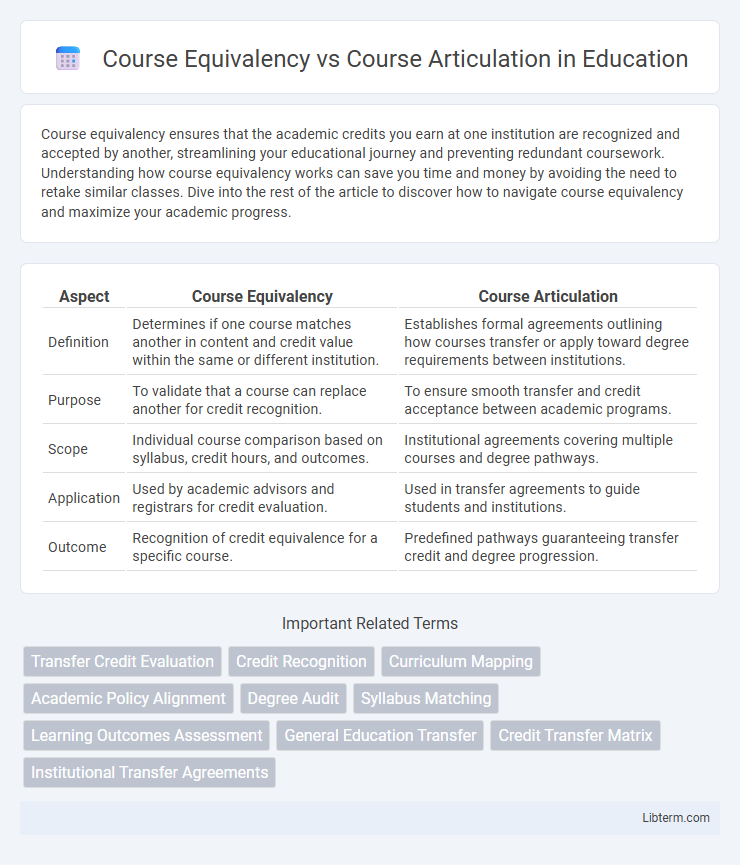Course equivalency ensures that the academic credits you earn at one institution are recognized and accepted by another, streamlining your educational journey and preventing redundant coursework. Understanding how course equivalency works can save you time and money by avoiding the need to retake similar classes. Dive into the rest of the article to discover how to navigate course equivalency and maximize your academic progress.
Table of Comparison
| Aspect | Course Equivalency | Course Articulation |
|---|---|---|
| Definition | Determines if one course matches another in content and credit value within the same or different institution. | Establishes formal agreements outlining how courses transfer or apply toward degree requirements between institutions. |
| Purpose | To validate that a course can replace another for credit recognition. | To ensure smooth transfer and credit acceptance between academic programs. |
| Scope | Individual course comparison based on syllabus, credit hours, and outcomes. | Institutional agreements covering multiple courses and degree pathways. |
| Application | Used by academic advisors and registrars for credit evaluation. | Used in transfer agreements to guide students and institutions. |
| Outcome | Recognition of credit equivalence for a specific course. | Predefined pathways guaranteeing transfer credit and degree progression. |
Understanding Course Equivalency
Course equivalency determines whether a course taken at one institution meets the academic standards and content requirements of a similar course at another institution, enabling students to transfer credits effectively. It involves evaluating syllabi, learning outcomes, and credit hours to ensure alignment between courses, thereby facilitating seamless academic progression. Understanding course equivalency helps students avoid redundant coursework and accelerates degree completion by recognizing prior learning.
Defining Course Articulation
Course articulation defines the formal process through which academic institutions establish agreements to recognize and transfer equivalent credits for specific courses, ensuring consistency in curriculum standards and learning outcomes. Unlike course equivalency, which assesses similarity between individual courses on a one-to-one basis, articulation agreements map comprehensive pathways, facilitating student transitions between programs or institutions. These agreements provide clarity for students and advisors by detailing which completed courses satisfy requirements in another academic program.
Key Differences Between Course Equivalency and Articulation
Course equivalency determines if one course matches the content and credit value of another, allowing direct substitution in degree requirements. Course articulation involves formal agreements between institutions to accept transfer credits, specifying how courses correspond across different curricula. Key differences include equivalency's focus on content and credit comparison, while articulation centers on transfer policies and institutional agreements.
How Course Equivalency Impacts Credit Transfer
Course equivalency directly impacts credit transfer by determining whether a course completed at one institution matches the content and learning outcomes of a course at another institution, enabling students to receive credit without retaking similar courses. When a course is deemed equivalent, the credits earned can be applied toward degree requirements, facilitating smoother academic progression and reducing time and cost for students. Institutions rely on detailed curriculum comparisons and official evaluations to establish equivalency, ensuring transfer credits maintain academic rigor and relevance.
The Role of Articulation Agreements
Articulation agreements play a crucial role in course articulation by formally defining how courses completed at one institution satisfy requirements at another, facilitating seamless student transfers. These agreements ensure that course content, credit hours, and learning outcomes align between institutions, promoting academic consistency and reducing redundancy. While course equivalency identifies comparable courses, articulation agreements provide the official framework for credit acceptance and degree progression across colleges.
Evaluating Transcripts for Course Equivalency
Evaluating transcripts for course equivalency involves analyzing course content, learning outcomes, and credit hours to determine if completed coursework matches the requirements of the new institution. This process ensures that students receive appropriate credit without repeating similar courses, facilitating a smoother transfer experience. Accurate course equivalency assessments rely on detailed syllabus comparisons, accreditation standards, and alignment with degree program objectives.
Common Challenges in Course Articulation
Common challenges in course articulation include discrepancies in curriculum content, varying credit hour requirements, and differences in learning outcomes between sending and receiving institutions. These issues create difficulties in ensuring seamless credit transfer and maintaining academic standards. Aligning course objectives and assessment criteria is essential to overcome articulation barriers and facilitate student progression.
Benefits of Clear Course Equivalency Policies
Clear course equivalency policies streamline the transfer process by ensuring students receive appropriate credit for previously completed coursework, reducing redundancy and saving time. These policies provide academic institutions with a standardized framework to evaluate course content, guaranteeing consistency and fairness in credit recognition. Enhanced transparency in equivalency criteria supports student retention and graduation rates by minimizing confusion and facilitating tailored academic planning.
Best Practices for Institutions Handling Articulation
Institutions handling course articulation should establish clear, standardized criteria for evaluating course equivalency to ensure consistent credit transfer and academic alignment. Implementing collaborative frameworks involving faculty subject-matter experts and registrars enhances accuracy in matching course content, learning outcomes, and credit hours. Utilizing comprehensive databases and articulation agreements streamlines the process, reduces duplication, and supports student mobility across institutions.
Student Tips for Navigating Course Transfers
Students should carefully compare course equivalency guides to understand how their completed coursework matches the curriculum at the new institution, ensuring credits transfer appropriately. Reviewing course articulation agreements between schools helps identify guaranteed credit transfers and prepares students for any required syllabus comparisons or prerequisite adjustments. Maintaining detailed academic records and consulting academic advisors can streamline the transfer process and prevent loss of credits.
Course Equivalency Infographic

 libterm.com
libterm.com